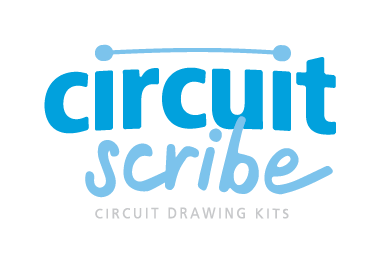The world of electricity right at their fingertips!
Watch and learn with your child as they discover how electricity works through a series of fun and educational projects using our Circuit Scribe products. Coach your child through the project by using the provided tutorials instructions and soon they will be on their way to learning the basics of electricity!
Potentiometer

Introduction
Resistance
You know when you slide a light dimmer or turn the knob on a stereo to change volume? Chances are you’re using a potentiometer. In this exercise, you’ll create your own paper potentiometer using lights, resistors, and a battery.
This activity is all about resistance or ways to inhibit the flow of electricity through a circuit. Along the way you’ll play with resistors, which are one of the fundamental components in electronics.
Step One
Gathering Resistors
The first thing you'll need to do is to get two or more Circuit Scribe DIY Connectors and the collection of resistors that comes with it.
You'll see that this module has 2 pairs of holes. As in the photos, take a resistor, bend the two wires downward and stick them into one hole on the left and one on the right. You'll feel them get pinched by metal inside the module that holds them in.
Step Two
Try Out Different Resistors with this Test Circuit
Next you'll draw the basic circuit pattern below.
Using the second photo as your guide, place a battery at the bottom of the circuit and an LED module at the top right. At the top left, try different resistors.
A note about resistors - These little wire-and-ceramic boo-bobs have stripes that denote how much resistance each one has, measured in ohms. If you want a deep dive into how they work and how to interpret those stripes, read our Intro to Resistance article here.
What you'll notice is that if you try different resistors in the module, you'll see the LED becomes significantly more or less bright. Each resistor inhibits the current a different amount! You can even line up the resistors from weakest to strongest for use in the next steps.
Download the test circuit pattern as a PDF here if you want to trace over a printout with our conductive ink.
Step Three
Make your Paper Potentiometer!
Ready to get potentiometer...ing? First, draw the circuit pattern at the top. We'll start with just two resistors. (You can download a PDF of this circuit pattern here if you want to print it out and trace it.)
Note: I'm using three modules with resistors in the PDF, and four in the images below; if you only have one or two DIY Connectors with resistors, that is enough.
The Big Idea here is this:
you'll see how bright an LED lights up in a small circuit with the battery
then you'll rotate the LED so the current goes through one resistor
you'll rotate the LED again so current passes through two resistors
add more resistors if you like
What you'll see is that the light gets dimmer as you pass current through more resistors.
Ready to try it?
Connect the battery to the bottom of the circuit. Place a DIY Connector with a resistor in it to the top left spot. This is all you need to get started.
Place an LED module with its right foot on the circle you've drawn that comes up from the right side of the battery. This will be your pivot foot of the LED. You'll swivel it around to different contacts to see the light get brighter or dimmer depending on which path the current is taking.
Swivel the LED to the left so you're making a very simple circuit with a battery sending current through the LED and back - you'll notice the light is bright.
Next, swivel the LED over to the right so that the current is now going through the battery, through the potentiometer, through the LED and back to the battery. Do you notice that the light is dimmer?
You've now made a basic potentiometer!
If you want to keep going, you'll basically add new resistors for the LED to swivel over to in order to get more resistance along the path.










